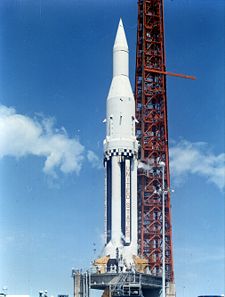.gif)
SA-4 (Apollo)
Encyclopedia
SA-4 was the fourth launch of a Saturn I
launch vehicle and the last of the initial test phase of the first stage. It was part of the Apollo Program
.
The major addition to this flight was that, in order to test the rocket's ability to deal with an engine failure during the flight, one of the engines would be programmed to shut down about 100 seconds after launch. If all went well the rocket would reroute the fuel for this engine to the other engines and have the rocket burn longer to compensate for the loss of acceleration. This was used successfully on the later Apollo 6
and Apollo 13
flights.
Also on this flight, the dummy second stage was outfitted with the aerodynamic design of the real second stage. This included vent ducts, fairings and dummy camera pods. The rocket also flew with antennae designed for the Block II version of the rocket.
 After the shortest checkout time of any rocket at 54 days, SA-4 went on to experience the longest series of holds of any mission at 120 minutes. The SA-4 launch would be the final single-stage flight.
After the shortest checkout time of any rocket at 54 days, SA-4 went on to experience the longest series of holds of any mission at 120 minutes. The SA-4 launch would be the final single-stage flight.
The rocket operated perfectly through the first 100 seconds of the flight, when the Number 5 engine shut off as planned. The rocket then continued to operate properly, the propellant system rerouting the fuel to the other engines. The Number 5 engine didn't disintegrate because of heat caused by the lack of cooling propellant as some had predicted. This was an important test proving an important feature of the clustered engine design.
The rocket reached a maximum height of 129 km and a peak velocity of 5906 km per hour. At this stage it also fired retrorockets that would be used on later missions to separate the rocket stages. On SA-4 the stages weren't designed to separate but tested the retrorockets to make sure they would fire.
Saturn I
The Saturn I was the United States' first heavy-lift dedicated space launcher, a rocket designed specifically to launch large payloads into low Earth orbit. Most of the rocket's power came from a clustered lower stage consisting of tanks taken from older rocket designs and strapped together to make...
launch vehicle and the last of the initial test phase of the first stage. It was part of the Apollo Program
Project Apollo
The Apollo program was the spaceflight effort carried out by the United States' National Aeronautics and Space Administration , that landed the first humans on Earth's Moon. Conceived during the Presidency of Dwight D. Eisenhower, Apollo began in earnest after President John F...
.
Objectives
SA-4 was the last flight to test only the S-I first stage of the Saturn I rocket. As with the first three launches this would be a suborbital flight and would test the structural integrity of the rocket.The major addition to this flight was that, in order to test the rocket's ability to deal with an engine failure during the flight, one of the engines would be programmed to shut down about 100 seconds after launch. If all went well the rocket would reroute the fuel for this engine to the other engines and have the rocket burn longer to compensate for the loss of acceleration. This was used successfully on the later Apollo 6
Apollo 6
Apollo 6, launched on April 4, 1968, was the Apollo program's second and last A type mission—unmanned test flight of its Saturn V launch vehicle. It was intended to demonstrate full lunar injection capability of the Saturn V, and the capability of the Command Module's heat shield to withstand a...
and Apollo 13
Apollo 13
Apollo 13 was the seventh manned mission in the American Apollo space program and the third intended to land on the Moon. The craft was launched on April 11, 1970, at 13:13 CST. The landing was aborted after an oxygen tank exploded two days later, crippling the service module upon which the Command...
flights.
Also on this flight, the dummy second stage was outfitted with the aerodynamic design of the real second stage. This included vent ducts, fairings and dummy camera pods. The rocket also flew with antennae designed for the Block II version of the rocket.
Flight

The rocket operated perfectly through the first 100 seconds of the flight, when the Number 5 engine shut off as planned. The rocket then continued to operate properly, the propellant system rerouting the fuel to the other engines. The Number 5 engine didn't disintegrate because of heat caused by the lack of cooling propellant as some had predicted. This was an important test proving an important feature of the clustered engine design.
The rocket reached a maximum height of 129 km and a peak velocity of 5906 km per hour. At this stage it also fired retrorockets that would be used on later missions to separate the rocket stages. On SA-4 the stages weren't designed to separate but tested the retrorockets to make sure they would fire.
External links
- The Apollo Spacecraft: A Chronology
- http://nssdc.gsfc.nasa.gov/database/MasterCatalog?sc=SATURNSA4
- Moonport: A History of Apollo Launch Facilities and Operations
- http://science.ksc.nasa.gov/history/apollo/sa-4/sa-4.html
- Stages to Saturn

